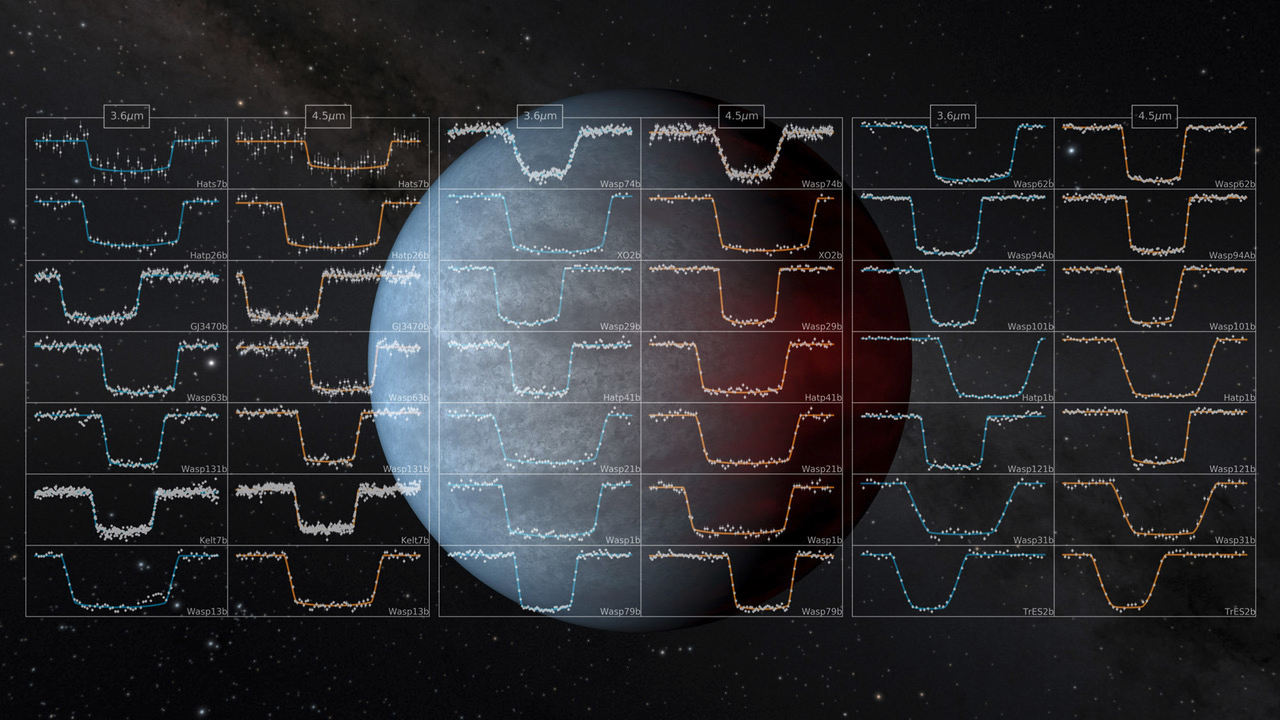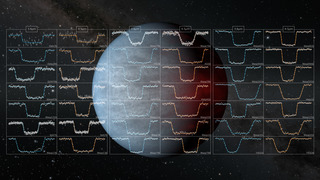
Artist's rendering of a "hot Jupiter," with samples of "light curve" data from hot Jupiters obtained by the Spitzer Space Telescope. Image credit: NASA/JPL-Caltech
News Release • July 26th, 2021 • ssc2021-05 •
Among the first, and strangest, planets to be detected around other stars is a variety known as “hot Jupiters” – star-hugging, superheated giants once thought so unlikely that many scientists doubted their existence.
But 25 years later, hot Jupiters have been confirmed across the galaxy and even in our stellar neighborhood. Now a survey using data from NASA’s Spitzer Space Telescope, switched off in 2020, is teasing out important features of hot Jupiter atmospheres and providing a few surprises for scientists.
Spitzer’s parting gift also offers a glimmer of the future – a coming revolution in our understanding of exoplanets, the worlds orbiting other stars.
Measurements of the temperature and chemical properties of hot Jupiters, and how these affect their cauldron-like atmospheres, were made by gathering light from the infrared part of the spectrum – the “heat maps” that were Spitzer’s specialty.
Far more detailed observations in the same tradition are expected from the James Webb Space Telescope, which will launch in 2021, and other instruments to come in the decades ahead.
“To me, the transition is going from more than 15 years of exoplanetary science with Spitzer to a new era,” said Jean-Michel Desert, an astronomer at the University of Amsterdam and a co-author of the new study. “The legacy of Spitzer for the future – that to me is the key moment.”
Families of planets
Hot Jupiters are gas giants, in some ways similar to our own Jupiter in terms of mass and size, but with far higher temperatures. They orbit their stars so tightly that a “year” – once around the star – can take just a few days. This short orbital leash keeps them infernally hot.
Astronomers have found more than 700 so far in our galaxy – so many that they now have been able to conduct the largest statistical survey of these extreme planets using Spitzer data.
The new study, involving 49 hot Jupiters – chosen in part because molecular signatures in their atmospheres could be measured more precisely – begins to reveal trends and commonalities in an entire population.
“Hot Jupiters – all of them are quite peculiar,” Desert said. “But we do see families of [these] exoplanets.”
The temperatures, masses and diameters of the 49 "hot Jupiters" examined in a new study, with Jupiter, Saturn and Neptune added for reference. Adapted from a figure in the paper. Image credit: NASA/JPL-Caltech
They seem to group into three families, the science team found: the “cooler” hot Jupiters, with atmospheric temperatures up to about 1,300 degrees Fahrenheit (700 degrees Celsius), “hot” hot Jupiters, from about 1,300 to 3,100 degrees Fahrenheit (700 to 1,700 degrees Celsius), and ultra-hot Jupiters, those above 3,100 Fahrenheit (1,700 degrees Celsius).
The most unexpected finding for scientists who study these behemoths: Among the cooler hot Jupiters, no trace of methane was seen in their atmospheres.
Computer models – simulations of hot Jupiter atmospheres – that are calculated using common scientific assumptions predicted methane in abundance for these worlds. The gas is present in small amounts in the atmosphere of our own (non-hot) Jupiter and plentiful in the gas giants Uranus and Neptune.
“We saw that some atmospheres behave differently compared to the [simpler models],” lead author Claire Baxter, also of the University of Amsterdam, wrote in an email. “To not find methane in any of the planets [at temperatures lower than about 1,300 degrees Fahrenheit] was surprising with the basic assumptions we had made.”
A few papers in previous years suggested a lack of methane on these planets, Desert said, but the question was whether these were anomalies or not. The new studies show, instead, that lack of methane at the cool end of the hot Jupiter spectrum is a widespread character trait.
“We know that simple models can’t match the data, and that we have to include more accurate physics into those basic models,” Desert said.
Another important result among the ultra-hot Jupiters is the evidence of vertical mixing in their atmospheres. Carbon monoxide and methane are stirred together on these planets, as interpreted from Spitzer data, with the strongest mixing on the hottest planets. Such a stew is best explained by mixing of the atmosphere’s upper and lower regions.
“Seeing the evidence for vertical mixing in a statistical sense is an important step because it is predicted by models and was also previously seen in brown dwarfs [a kind of failed star],” Baxter wrote. “Now we have collected evidence that this effect is also seen in exoplanet atmospheres.”
A chip off the old parent star
A third finding helps improve understanding of a long-running mystery. Some previous analyses suggested that hot Jupiters might have a higher metal content than their stars, which would be difficult to explain.
But the Spitzer data from the new survey appears to put that concern in a different light. The Spitzer observations fit the picture of planets with about the same chemical composition as their stars, which would be expected from planets and stars that formed from the same protoplanetary disk.
As in most families, the various members of the hot Jupiter groups have plenty of individual quirks, while still maintaining close relations.
“We’re not necessarily claiming we’re the first to see diversity [among hot Jupiters],” Desert said. “What is nice is that we see it statistically, looking at 50 objects that we’ve analyzed and interpreted in a systematic way.”
And while the Webb telescope and its successors will be able to analyze the atmospheres of individual planets more deeply, another broad survey of hot Jupiters – analyzing a large population to find common characteristics – might not be possible in the immediate future. The European Space Agency’s ARIEL mission, which will carry the CASE instrument developed by NASA’s Jet Propulsion Laboratory and is expected to launch in 2029, is designed to conduct a broad-scale survey of exoplanet atmospheres.
The new study, in a way, also brings the retired Spitzer Space Telescope full circle. One of the earliest news releases issued about Spitzer’s discoveries, in 2005, involved its capturing of infrared light from two hot Jupiters – a “first” at the time.
That also was hailed as the start of a new era in planetary science.
The extensive data collected by Spitzer continues to yield discoveries, but the baton is being passed to a new generation of more powerful infrared instruments. They will seek to unravel more mysteries, perhaps including the formation of small, rocky, potentially habitable worlds like our own.
“Our work is the result of the huge efforts of Spitzer in the field of exoplanet science over the last 15 years,” Baxter wrote. “Our work will serve as a benchmark for infrared studies in the future of exoplanet science. It allows us to understand planetary atmospheres in a broad context, which helps us understand planet formation and evolution.”





